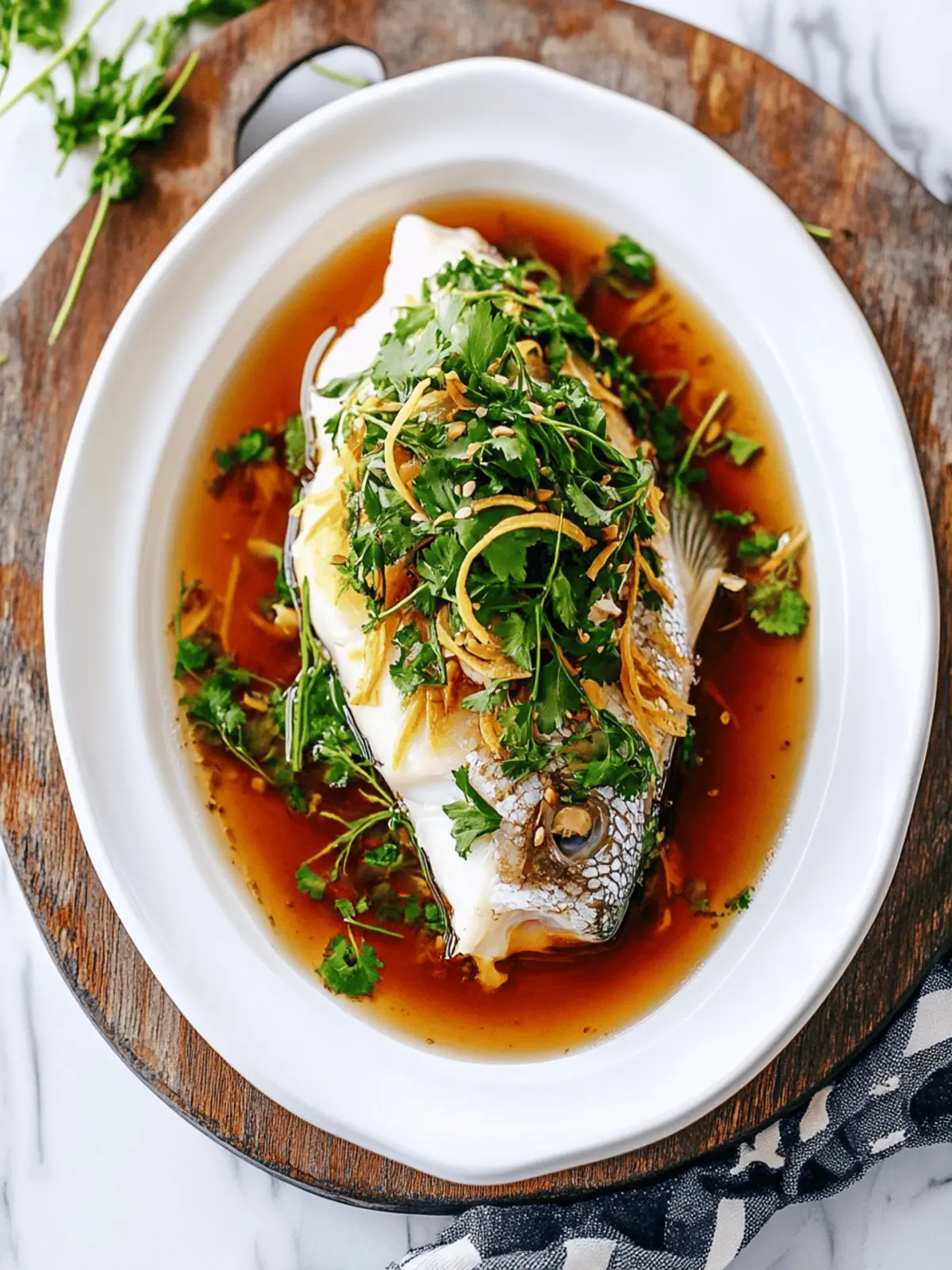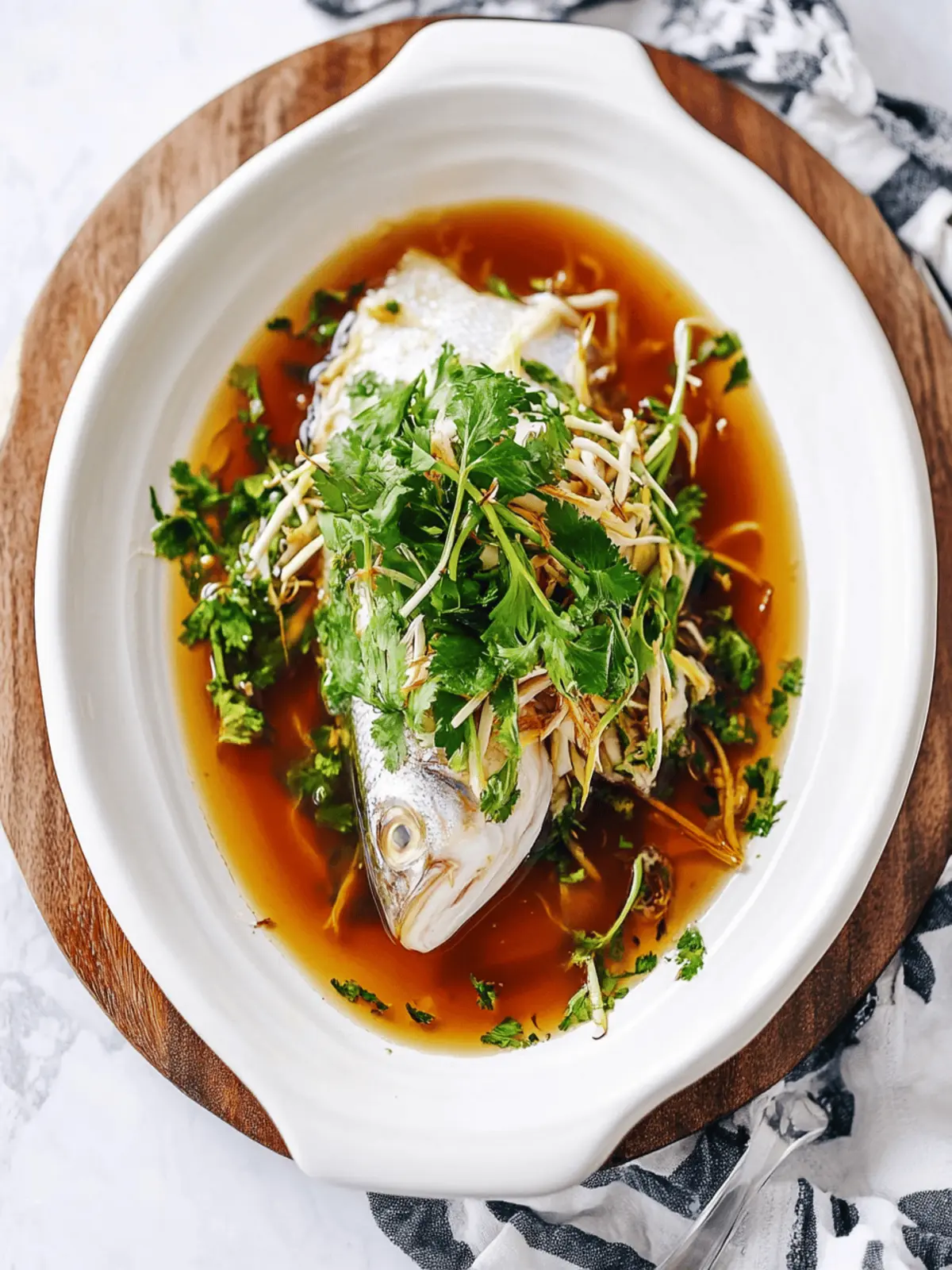As the sun begins to set and the aroma of dinner fills my kitchen, there’s nothing more satisfying than preparing a dish that embraces both tradition and ease. This Cantonese Steamed Fish recipe has become a go-to for me on busy weeknights when I crave something nourishing without the fuss. With only 20 minutes from start to finish, you’ll experience tender, flaky fish infused with fragrant ginger and vibrant scallions—making each bite a delightful journey into Cantonese cuisine.
This dish isn’t just a quick meal; it’s a celebration of flavors that transforms simple ingredients into an elegant dinner worthy of any occasion. Whether I’m hosting friends or simply filling my plate after a long day, this steamed fish paired with fluffy rice always impresses. And if you’re in search of a healthy, gluten-free option that’s light yet satisfying, look no further! Let’s dive into this easy recipe that’s sure to elevate your weeknight dinners.
Why Will You Love Cantonese Steamed Fish?
Quick Preparation: With just 20 minutes, you’ll have a delicious, nutritious meal ready.
Flavors Galore: The aromatic blend of ginger and scallions infuses vibrant taste throughout the dish.
Healthy Cooking: This recipe is not just quick, but also gluten-free and packed with protein—perfect for health-conscious eaters.
Versatile: Easily adaptable to different types of fish or added veggies for a personalized spin.
Impressive Presentation: The colorful ingredients and steaming technique create a visually stunning dish that’s sure to impress guests.
Satisfies Cravings: Enjoy the comforting satisfaction of homemade Cantonese cuisine, making your weeknight dinners feel special!
Cantonese Steamed Fish Ingredients
• Discover the essentials for perfect Cantonese Steamed Fish!
For the Marinade
- Light Soy Sauce – Provides umami and saltiness; substitute with low-sodium soy sauce for a healthier option.
- Salt – Enhances flavor; kosher or sea salt works beautifully here.
- Sugar – Balances the saltiness; brown sugar can be used as a delightful alternative.
- Hot Water – Helps dissolve the marinade ingredients for an even distribution of flavor.
For the Fish
- Delicate White Fish Fillet (e.g., haddock, flounder, sea bass) – The star of the dish; fresh fillets ensure the best taste, avoiding oily fish varieties.
- Vegetable Oil – Used to fry the aromatics; consider canola oil for a neutral flavor or sesame oil for an added kick.
For the Aromatics
- Scallions – Adds a fresh onion flavor and crunch; can be substituted with green onions in a pinch.
- Ginger – Imparts warmth and spice; always opt for fresh ginger for optimal flavor.
- Cilantro – Enhances aroma and adds freshness; parsley can be used as a milder substitute.
How to Make Cantonese Steamed Fish
-
Prepare the Aromatics: Cut scallions into 2-inch lengths, julienne the fresh ginger, and chop the cilantro roughly. This blend of aromatics lays the foundation for the dish’s delightful flavor.
-
Mix the Marinade: In a bowl, whisk together light soy sauce, salt, sugar, and hot water until fully dissolved. Set this flavorful mixture aside to meld the tastes.
-
Prepare the Steaming Setup: Fill a wok or pot with 1-2 inches of water and bring it to a gentle boil. This steam will delicately cook your fish to perfection.
-
Rinse and Position the Fish: Gently rinse the fish fillet under cold water and place it on a heat-proof plate that fits into your steamer. This is where the magic happens!
-
Steam the Fish: Carefully set the plate with the fish into the steamer and cover it. Steam the fillet for 7-10 minutes (4-5 minutes for thin fillets) or until it flakes easily when tested with a dull knife.
-
Add Aromatics: Once the fish is perfectly cooked, drain any liquid from the plate and sprinkle about one-third of your aromatics over the top to enhance flavor and presentation.
-
Heat the Oil: In a separate saucepan, heat vegetable oil over medium heat. Fry the remaining ginger and scallion whites until they become aromatic and sizzling, releasing their vibrant flavors into the oil.
-
Combine and Serve: Pour the soy sauce mixture into the hot oil, letting it come to a gentle bubble. Then, pour this aromatic blend over the steamed fish. Serve immediately for the best taste!
Optional: Garnish with additional cilantro for a fresh finish.
Exact quantities are listed in the recipe card below.
How to Store and Freeze Cantonese Steamed Fish
Fridge: Store leftover steamed fish covered in the refrigerator for up to 3 days. Ensure it’s well-wrapped to maintain freshness and prevent odors from being absorbed.
Freezer: For longer storage, freeze cooked fish in an airtight container for up to 2 months. To reheat, thaw overnight in the fridge and steam gently to retain moisture.
Reheating: Reheat steamed fish by placing it back in the steamer for about 5 minutes, or until heated through, preserving its tender texture.
Make-Ahead Tip: While fresh fish is best prepared immediately, you can marinate the fish in the soy mixture a couple of hours ahead for added flavor.
Make Ahead Options
These Cantonese Steamed Fish are fantastic for meal prep, allowing you to save time during busy weeknights! You can marinate the fish (using the soy sauce mixture) up to 24 hours in advance, which not only infuses flavor but keeps the fish tender. Additionally, you can prep the aromatics (scallions, ginger, and cilantro) a day ahead; simply store them in an airtight container in the refrigerator to maintain their freshness. When you’re ready to enjoy your meal, just steam the fish for about 7-10 minutes, top with prepped aromatics, and drizzle over the hot oil mixture—resulting in a quick, delicious dish that feels like a special treat!
What to Serve with Cantonese Steamed Fish?
Elevate your Cantonese Steamed Fish dinner with delightful pairings that enhance its vibrant flavors and create a well-rounded meal.
- Steamed White Rice: A classic companion, fluffy rice soaks up the flavorful soy sauce, balancing the dish beautifully.
- Sautéed Bok Choy: This crunchy green adds a fresh, crisp texture to your plate and complements the mild fish perfectly.
- Miso Soup: The warm, savory broth provides a comforting, umami-rich experience that harmonizes with the dish’s delicate flavors.
- Pickled Ginger: A tangy contrast, it cleanses the palate between bites, enhancing the overall dining experience with its zesty kick.
- Chili Oil Drizzle: For those who like a little heat, a drizzle of chili oil adds a spicy punch that tantalizes the taste buds.
- Cold Sesame Noodles: These noodles introduce a refreshing contrast with their chewy texture and nutty flavor, making for a satisfying meal.
- Green Tea: A soothing and light drink that serves as the perfect counterbalance to the rich flavors of the steamed fish.
- Mango Sticky Rice: This sweet dessert provides a delightful finish, combining creaminess with natural sweetness for an unforgettable end to your meal.
- Cucumber Salad: A light and refreshing salad brings a crisp, cool element that not only enhances the meal but also adds a splash of color to your plate.
- Crusty French Bread: For a fusion twist, crusty bread can be served on the side, perfect for soaking up any leftover sauce and enjoying every last bite.
Tips for the Best Cantonese Steamed Fish
- Choosing the Right Fish: Use delicate white fish fillets like haddock or flounder for the best results. Avoid oily varieties to maintain the dish’s lightness.
- Watch the Time: Steam the fish for 7-10 minutes, checking for doneness early to prevent it from becoming overcooked and tough.
- Proper Marinade Mixing: Ensure the marinade ingredients are fully dissolved for even flavor distribution; stir well before pouring over the fish.
- Test for Doneness: Use a dull butter knife to check if the fish flakes easily; it should be tender but not mushy.
- Presentation Matters: For a restaurant-quality look, drizzle hot oil over the raw aromatics right before serving to enhance the dish’s color and aroma.
Variations & Substitutions for Cantonese Steamed Fish
Feel free to personalize this dish to suit your taste and dietary preferences for an even more delightful experience!
- Spicy Twist: Add chopped red chilies or a drizzle of chili oil for an added kick that warms the palate.
- Fish Alternative: Swap in cod or tilapia instead of the suggested fish fillets for a different flavor profile.
- Veggie Boost: Include sliced shiitake mushrooms or julienned carrots in your steaming setup for an extra layer of flavor and nutrition.
- Herb Substitution: If cilantro isn’t your favorite, use fresh parsley or basil to maintain that delightful freshness.
- Heat Level Adjust: For a milder taste, replace light soy sauce with coconut aminos, offering a sweeter, less salty option that’s gluten-free.
- Citrus Flavor: Squeeze fresh lemon or lime juice over the fish just before serving for a bright and zesty finish.
- Coconut Creamy: Drizzle a tablespoon of coconut milk over the fillets prior to steaming for a richer, creamier flavor that still feels light.
- Soy-Free Option: Use tamari or a mushroom-based sauce to replace soy sauce for a gluten-free and soy-free alternative.
Experiment with these variations, and make this dish truly your own!
Cantonese Steamed Fish Recipe FAQs
How do I select the freshest fish for steaming?
Absolutely! When choosing your delicate white fish fillet for Cantonese Steamed Fish, look for bright, clear eyes and vibrant, shiny skin. The flesh should be firm to the touch and have a mild ocean scent. Avoid any fillets that show dark spots or have a strong fishy odor. Freshness is key for that melt-in-your-mouth experience!
How should I store leftover Cantonese Steamed Fish?
Very! To store leftover steamed fish, cover it tightly with plastic wrap or transfer it to an airtight container and keep it in the refrigerator. It may remain fresh for up to 3 days. It’s essential to ensure that it’s well-wrapped to maintain its freshness and prevent it from absorbing any unwanted odors.
Can I freeze Cantonese Steamed Fish?
Yes, you can! To freeze cooked Cantonese Steamed Fish, place it in an airtight container, ensuring it’s completely cooled before sealing. It can be frozen for up to 2 months. When you’re ready to enjoy it again, simply thaw it overnight in the refrigerator and then reheat it gently by steaming for about 5 minutes.
What if my fish becomes tough when steaming?
Oh no! If your fish turns out tough, it may have been overcooked. Steam the fish for 7-10 minutes, depending on the thickness; using a dull butter knife to test for doneness is effective. The fish should flake easily when done. To prevent this in the future, always check the doneness a couple of minutes early to avoid overcooking.
Are there any dietary considerations I should be aware of?
Certainly! This Cantonese Steamed Fish recipe is naturally gluten-free if you use gluten-free soy sauce like tamari. For those with seafood allergies, substitute the fish with a protein that’s suitable for you, like chicken or tofu. As always, if serving to children or pets, be cautious of any bones in the fish and always supervise while eating.
Can I prepare the fish ahead of time?
You sure can! For added flavor, marinate the fish in the soy mixture a couple of hours before cooking. Just be sure not to keep it marinated for too long, as the salt can draw moisture from the fish, making it less tender. This step can significantly enhance the dish’s taste while still keeping your dinner prep quick and simple!

Cantonese Steamed Fish: A 20-Minute Flavor Explosion
Ingredients
Equipment
Method
- Cut scallions into 2-inch lengths, julienne the ginger, and chop the cilantro roughly.
- In a bowl, whisk together light soy sauce, salt, sugar, and hot water until fully dissolved.
- Fill a wok or pot with 1-2 inches of water and bring it to a gentle boil.
- Gently rinse the fish fillet under cold water and place it on a heat-proof plate.
- Carefully set the plate with the fish into the steamer and cover it.
- Steam the fillet for 7-10 minutes or until it flakes easily when tested.
- Once the fish is cooked, sprinkle one-third of your aromatics over the top.
- In a saucepan, heat vegetable oil over medium heat and fry the remaining ginger and scallion whites.
- Pour the soy sauce mixture into the hot oil and let it come to a gentle bubble, then pour over the steamed fish.











